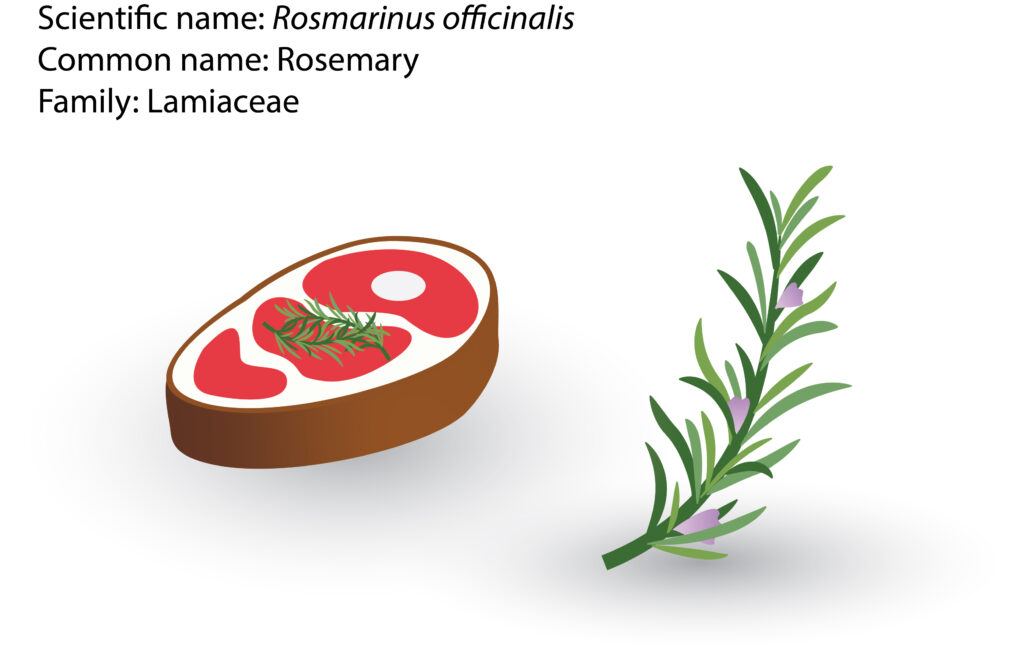Rosemary is a widely grown garden plant that is known as a culinary herb, in which this species also can be planted as an ornamental plant. Rosemary is scientifically known as Rosmarinus officinalis that is under the family of Lamiaceae. It is an upright with a strong woody shrub. This woody shrub is densely clothed with narrow and deep green leaves that ranged about one inch. Some botanists recognize up to twelve species in this genus. However, the most suggest there is only one, an evergreen native to the Mediterranean. It has been valued for centuries for its perfume and medicinal and culinary uses.
Rosemary is a herb that prefers a sunny site and thrives in poor soil if it is well-drained. It is a salt-tolerant plant. It is a small shrub rarely growing more than four feet tall. It has narrow and needle-like leaves that are dark green and aromatic. This is because it consists of aromatic essential volatile oil. Regular pruning is useful to keep it at a compact canopy and promote new growth of the shoots. Occasionally, it will form lavender-blue to deep blue flowers that are held in short clusters. Therefore, it can be either propagated through the seeds that are the products of pollination or through cuttings in the summer.
Rosemary has several varieties. For instance, Rosmarinus officinalis ‘Beneden Blue’ is rosemary that has vivid blue flowers. ‘Huntingdon Carpet’ is a low spreader with blue flowers. ‘Lockwood de Forest’ has deep blue flowers and a spreading habit. Then, ‘Majorca Pink’ is an upright grower with soft pink flowers. ‘Miss Jessop’s Upright’ grows vigorously to six feet. ‘Prostratus’ or commonly known as Rosmarinus lavendulaceus of gardens, is a ground-cover form that is ideal for spilling over walls or covering banks. Lastly, the variety ‘Tuscan Blue’ bears dark blue flowers.
Rosemary extract is approved for the use in European Union as a food additive. It is used for flavor and aromatic reasons traditionally apart from its antioxidant properties. Most importantly, it is currently widely used to increase the shelf life of food products due to the high antioxidant activity of its main components. It consists of a high concentration of carnosic acid. Furthermore, rosemary was also found to have the potential of having anti-microbial, anti-fungal, anti-viral, anti-inflammatory, hypoglycemic, hypolipidemic, hypotensive, anti-atherosclerotic, anti-thrombotic, hepatoprotective, and hypocholesterolemic effects. Historically, rosemary has been used medicinally to treat renal colic and dysmenorrhea. It has also been used to relieve symptoms caused by respiratory disorders and to stimulate hair growth.
Rosemary is considered a spice that is used as a flavor and aromatic agent due to its woody property. It is widely used in cooking as a spice. With the development of the food industry, foods are expected to have a longer shelf-life to withstand storage and logistics. Preservatives were found to suppress microbial spoilage. Rosemary extracts especially herbal products were shown to be one of the most popular herbal products that have been consumed as a flavoring and antioxidant agent in food conservation and cosmetics. Historically, rosemary has been used medicinally to treat renal colic and dysmenorrhea. It has also been used to relieve symptoms caused by respiratory disorders and to stimulate hair growth. Traditionally, rosemary leaf is used to treat dyspepsia and its oil is applied externally for joint pain and poor circulation in Germany.

Further readings:
Ulbricht, C., Abrams, T. R., Brigham, A., Ceurvels, J., Clubb, J., Curtiss, W., Kirkwood, C. D., Diese, N., Hoehn, K., Iovin, R., Issac, R., Rusie, E., Serrano, J. M. G., Varghese, M., Weissner, W., & Windsor, R. C. (2010). An evidence-based systematic review of rosemary (Rosmarinus officinalis) by the natural standard research collaboration. Journal of dietary supplements. 1939-0211.
Raadt., P., Writz, S., Vos, E., & Verhagen, H. (2015). Short review of extracts of rosemary as a food additive. Europe jpurnal of nutrition & food safety. 5(3), 126-137.
Hassani, F. V., Shirani, K., & Hosseinzadeh, H. (2016). Rosemary (Rosmarinus officinalis) as a potential therapeutic plant in metabolic syndrome: a review. Naunyn-Schmiedeberg’s Arch Pharmacol. 1-19.
Xie, J., VanAlstyne, P., Uhlir, A., & Yang, X. (2017). A review on rosemary as a natural antioxidation solution. European journal of lipid science and technology. 119-129.
Nieto, G., Ros, G., & Castillo, J. (2018). Antioxidant and antimicrobial properties of rosemary (Rosmarinus officinalis L.): A review. Medicines. 5, 98.